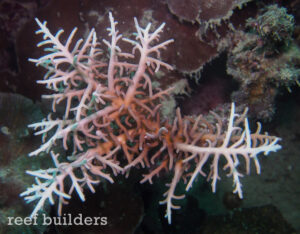One of the most exciting outcomes we could have hoped for on the Fluval Sea Flores Expedition is to encounter some corals that have never been seen before. Early on we observed not one but two species of Acropora the likes of which we have never seen in person or documented with photographs. We already told you about the first of these stony coral finds we are provisionally calling Acropora sp. “Flores 1” and this is the account of Acropora sp. “Flores 2”.
The unknown Flores Acropora corals were often found growing in the same kinds of reef habitat, a moderate depth, sheltered reef slop with a noticeable degree of particulate matter raining on the reef. The species we are calling Acropora sp. “Flores 2” was not hard to find since on at least a couple occasions we were greeted to this coral on the first dive at a new site.
What makes Acro Flores 2 so distinctive is that it is a typical “smooth-skinned” “deepwater” Acropora coral but with a colony shape that is bottlebrush to the fullest. The bottlebrush shape of Acro Flores 2 is extremely pronounced and the central branch is surrounded by long, smooth side branches which very rarely divide any further. In shallower depth or brighter light the branches of Acro Flores 2 can get a little more compact and branch more frequently while at the deep end of the habitats we observed, and where the conditions are more turbid and dimmer, Acro Flores 2 can splay its shape and flatten out to catch more light.
All but one of the colonies of Acro Flores 2 was cream white in color with the base of the side branches and young radial corallites colored a darker brown coloration, giving this unknown species a very unique appearance. However, on the last dive of the expedition we happened on a habitat that was rich with both Acro Flores 1, Acro Flores 2 and Acropora derawanensis – at this particular site Acro Flores 2 was seen in a fluorescent green coloration but with the same distinctive “spiny bottlebrush” shape.
Our initial impression of Acropora sp. “Flores 2” was that it could be an Acropora turaki, a common coral in the American reef scene that is traded as the “Hawkins Echinata”. But Acropora turaki is much finer in structure, and is more frequently branching than Acro Flores 2. Furthermore, Acro Flores 2 has a much sturdier overall build with more a of a tapering shape to the side branches, and the near 90 degree angle at which they project from the main branch is quite notable among Acropora species.
Time and more material collections will be required to confirm the true nature and identity of the coral we’ve come to call Acro Flores 2 but in the meantime, we are encouraged that Acropora were among the colonies that have us excited at the prospect that there are still many coral discoveries to be made in the wild.




